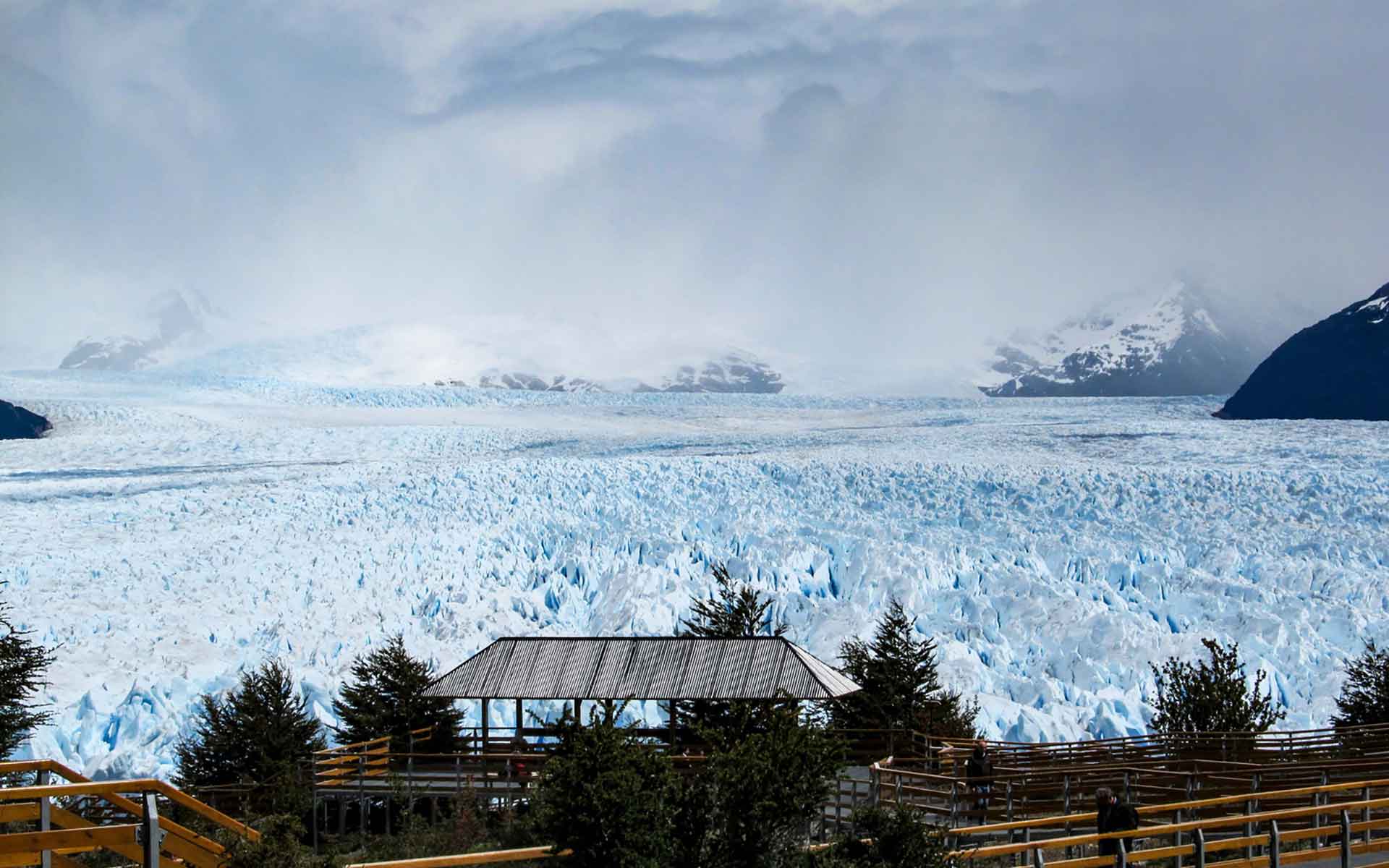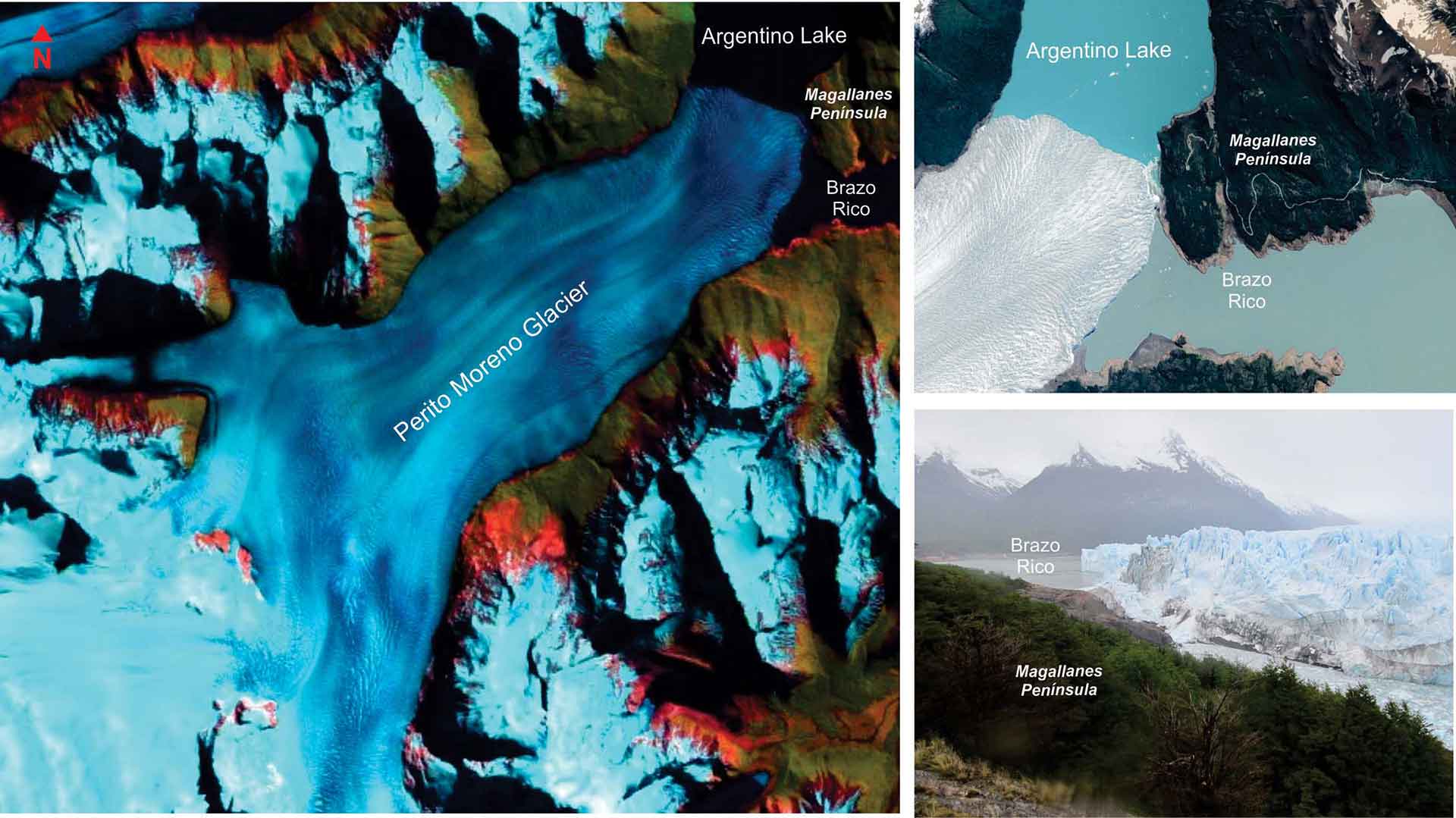
Panoramic view of the Perito Moreno Glacier (photo courtesy of Leonardo Escosteguy).
Geological Period
Pleistocene-Holocene
Main geological interest
Geomorphology and active geological processes
Location
Santa Cruz province / Argentina.
50°28’45.0″S, 73°03’58.0″W
Panoramic view of the Perito Moreno Glacier (photo courtesy of Leonardo Escosteguy).
AN AMAZING GLACIER FRONT AND A STABLE GLACIER IN THE FACE OF GLOBAL WARMING.
The Perito Moreno Glacier is an iconic site in the Patagonia Argentina included in the Los Glaciares National Park, declared as World Heritage Site by UNESCO in 1981. It has well-defined limits (Aniya and Skvarca, 1992), great accessibility and infrastructure (you can even walk on it) that gives the area educational potential. Besides the anomalous and periodic unique behavior of this glacier (Skvarca et al., 2004), the area offers an excellent example of the significant process of glaciation, as well as of geological, geomorphic and physiographic phenomena caused by the advance and retreat of the glaciations, which took place during the Pleistocene Epoch (Pasquini and Depetris, 2011).
- Geological description
The Perito Moreno is one of the most important glaciers that break off from the Southern Patagonian Ice Field located in the southern chain of the Andes (Argentina and Chile). This icefield is the last reliect of the greatest glacial expansions that occurred form the late Miocene to the late Pleistocene. This glacier is approximately 30 km long. Its front is 5 km long and has walls up to 60 m high (Aniya and Skvarca, 1992; Stuefer et al., 2007). The glacier penetrates Argentino Lake, but its base maintains contact with the rocky substratum. It´s a temperate or humid base glacier with a unique dynamic behavior. In this sense, its front presents a condition of stability (Stuefer et al., 2007; Ciappa et al., 2010), with brief oscillations (advances) that, when colliding with the western end of the Magallanes Peninsula, periodically causes the temporary blockage of Brazo Rico (as a dam), raising its water level. This situation generates differential stresses at the end of the glacier and causes the progressive transfer of water to the Argentino lake through a tunnel excavated in the ice. The roof of the tunnel collapsed in 1995, which was a spectacular event that made the glacier famous internationally (Del Valle et al., 1995).
- Scientific research and tradition
Perito Moreno is one of the few glaciers in the Southern Patagonian Ice Field that have not retreated during the last 50 years (Ciappa et al., 2010).This makes it something special in the face of global warming, which has motivated numerous investigations (e.g. Pasquini and Depetri 2011). Likewise, for greater attractiveness, the ice terminus periodically reaches the Magallanes Peninsula, generating an “ice dam” that finally collapses due to the pressure of the water (Del Valle et al., 1995).
- Reference
Aniya, M. and Skvarca, P. (1992) ‘Characteristics and variations of Upsala and Moreno glaciers, southern Patagonia’, Bulletin of Glacier Research, 10, pp. 39–53.
Ciappa, A., Pietranera, L. and Battazza, F. (2010) ‘Perito Moreno Glacier (Argentina) flow estimation by COSMO SkyMed sequence of high-resolution SAR-X imagery’, Remote Sensing of Environment, 114, pp. 2088–2096. Available at: https://doi.org/10.1016/J.RSE.2010.04.014.
Del Valle, R. et al. (1995) ‘A preliminary study of sediment cores from Lago Argentino and fluctuations of Moreno Glacier, Patagonia’, Bulletin of Glacier Research, 13, pp. 121–126.
Pasquini, A.I. and Depetris, P.J. (2011) ‘Southern Patagonia’s Perito Moreno Glacier, Lake Argentino, and Santa Cruz River hydrological system: An overview’, Journal of Hydrology, 405(1), pp. 48–56. Available at: https://doi.org/10.1016/j.jhydrol.2011.05.009.
Skvarca, P., Naruse, R. and Angelis, H.D. (2004) ‘Recent thickening trend of Glaciar Perito Moreno, southern Patagonia’, Bulletin of Glaciological Research, 21, pp. 45–48.
Stuefer, M., Rott, H. and Skvarca, P. (2007) ‘Glaciar Perito Moreno, Patagonia: climate sensitivities and glacier characteristics preceding the 2003/04 and 2005/06 damming events’, Journal of Glaciology, 53(180), pp. 3–16. Available at: https://doi.org/10.3189/172756507781833848.
- Author(s)
Martin Gozalvez
Geological and Mining Survey of Argentina (SEGEMAR)
Fernando Miranda
Geological and Mining Survey of Argentina (SEGEMAR)


